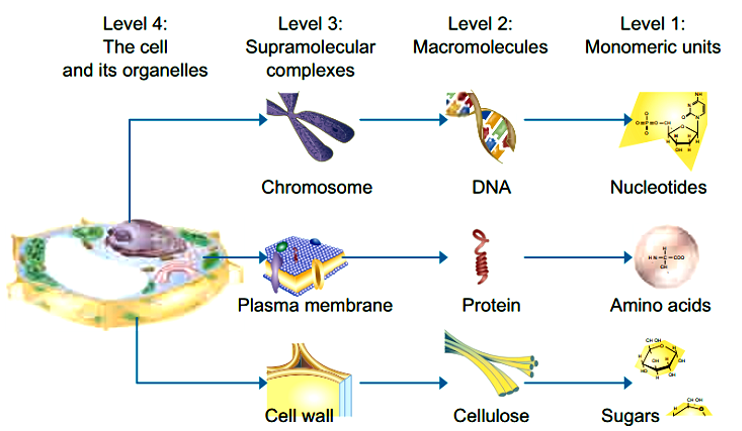- The total biomolecules found in a cell is commonly known as cellular pool
- It consists of both inorganic and organic compounds.

The cellular pool consists of
-
- Water – 65
-
- Inorganic materials
- Carbon, Hydrogen, Oxygen – 93
- Major Metal elements – 5
- Major non-metal elements – 2
- Minor metal elements – traces (Zn, Mn, Mo, Co)
- Minor non-metal elements – traces (F, I, B, Se)
- Major Metal elements – 5
- Carbon, Hydrogen, Oxygen – 93
- Organic Materials
- Carbohydrates
- Lipids
- Amino acids
- Nucleotides
- Nucleic acids
- Vitamins
- Proteins
- Inorganic materials
1. Water
- Water is the most abundant component in living organisms.
- Life on earth is inevitably linked to water.

- Water makes up 70
Function of water in living organisms
- Water makes up 2/3 rd of the body weight.
- Due to its solvent action, water forms an ideal medium for chemical reactions.
- Water is a reagent and is a source of H+ and OH– ions for many biochemical reactions.
- Water maintains molecular conformations and stabilizes structural organization of living matter.
- The high specific heat and mobility of water distribute heat uniformly throughout the body.
- Water helps in heat loss by convection and radiation from skin surface and plant surface.
- High latent heat of evaporation of water causes elimination of excess heat through evaporation of sweat and maintains a constant body temperature.
- Water helps in transport of substances within the body (of plants/animals) and elimination of waste products.
2. Inorganic Materials
The inorganic materials or minerals are of two types:
- Macronutrients – Required in larger amounts
- Micronutrients – Required in trace amounts
They are essential for the activity of enzymes.
- Manganese is required for activity of enzyme needed for synthesis of oligosaccharides and glycoproteins.
- Molybdenum is necessary for fixation of nitrogen by enzyme nitrogenase.
The minerals found in animal body are
- Macro-Elements: Sodium, Potassium, Calcium, Phosphorus, Sulphur, Nitrogen and Magnesium.
- Micro-Elements Zinc, Molybdenum, Iron, Copper, Manganese, Iodine and Fluorine.
The minerals found in animal body are
- Macro-Elements : Nitrogen, Phosphorus, Sulphur, Potassium, and Magnesium
- Micro-Elements: Zinc, Manganese, Molybdenum, Boron and Chloride.
Functions of minerals
(i) Minerals serve as structural or cellular components.
- Calcium pectate forms the middle lamellae of cell wall..
- Phosphorus as phospholipids forms part of all membranes.
(ii) Minerals also form part of biologically important compounds/substances.
- Magnesium is the central atom in chlorophyll
- Iron forms a component of haemoglobin and cytochromes
- Iodine is a part of thyroxine hormone.
(iii) Minerals also influence the action of enzymes, by functioning as prosthetic groups.
(iv) Sodium and potassium along with chloride are responsible for maintaining fluid balance.
(v) Sodium and potassium are important for conduction of nerve impulse and also for the transport of certain substances.
(vi) Certain elements are involved in maintaining the pH of intracellular and extracellular fluids.